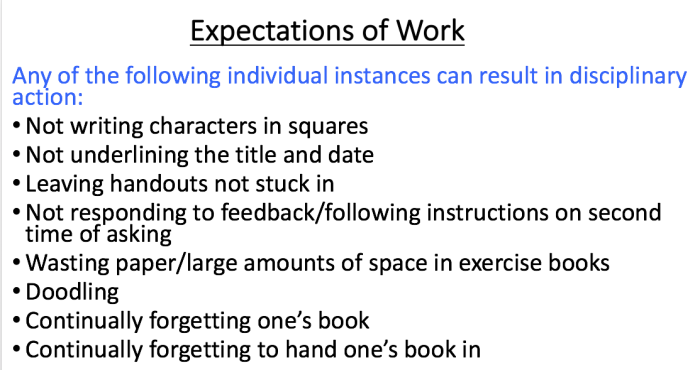We are all too familiar with that dreaded word “marking” – but it is without a doubt one of the most important aspects of teaching.
The motivation for this blog post has stemmed from the amount of time I routinely spend marking and the wonderment in why it takes me SO long to mark my pupils’ books!
That said, I have 199 pupils and if I spend approximately five minutes marking each pupil’s books, that’s up to 2000 minutes in total – feel free to do the math!
Over the course of the last year, I have been thinking hard on how to mark more productively. Particularly when a subject such as Mandarin requires much attention to detail e.g. spacing, basic strokes, stroke order, proportion – and that’s just for characters!
What will follow in today’s blog post is the employment of tried and test methods of different strategies and approaches to marking, both to enhance pupil progress and make marking generally more proficient.
Making Expectations of Work Clear
This I cannot emphasise enough as pupils generally have a strong tendency not to even carry out the very basic principles of good classwork, even though they do naturally know what those expectations are as drilled into them at primary school.
Here is a copy of what we use in our school which is stuck inside the front cover of pupils’ books:

Pupils are also told that if they do not meet these expectations that they will be back at lunchtime to ensure their book is up to date in regards to the above requirements. If pupils follow these expectations, it saves hours of time spent marking!
Marking Key
What I have trialled in the last year which has worked pretty well is the following marking key:

The advantage of this marking key is that the positive comments promote more use of the TL in addition to increasing pupils’ range of vocabulary. As pupils are made aware that the positive comments are always in Chinese, they will endeavour to look for what it means.
As for the symbols explained in the grid above, these enable the teacher to provide feedback more efficiently, in addition to eliminating the issue of pupils not understanding the teacher’s writing (especially mine as it is pretty awful!). An advantage of this method of marking is that pupils are encouraged to actively respond and act on the feedback provided, thus facilitating a reduction in marking time.
It is wise to routinely set aside time in the lesson for pupils to respond to feedback to allow pupils time to look through and check for any mistakes they have made so that they know to try and avoid making the same ones again in the future.
The only disadvantage of this marking method time wise is that you have to go over the work that has been marked to see if the pupil has responded to your comments. However, the progress the pupils make as a result is astounding – so definitely worth the investment!
Two Stars and a Wish
If I am perfectly honest, I believe this term to be a little ambiguous for pupils and useless unless pupils actively respond to the feedback written.
A term that I believe would be much less ambiguous is to just to make it more explicit e.g. to name it “Two Ps and a T” (Two Praises and a Target) or something along those lines so the pupils know what it is you are talking about – as there are still pupils even after months of this process who still do not know what two stars and a wish actually is!
The target should then be responded to by the student to signify how they will act upon it. I often just put a question mark underneath the target for them to respond to.
As it is departmental policy to use two stars and a wish, we therefore follow the format below:
* (positive point 1)
*(positive point 2)
WISH: (improvement target)
? – (how the student will achieve the improvement target)
One huge benefit of this method is that it clearly holds pupils accountable for their own learning and progress, which takes the onus off us a little!
Peer Marking
In addition, I often use this method during peer assessment, where pupils mark each other’s work which also enables you to see how effectively they are able to spot mistakes and deliver constructive feedback. If you are to do this though, ensure that the pupil signs their name so you know who it is who gave the feedback. This is because some feedback given can be unspecific, and you will have to chase up this pupil to ensure that the feedback they gave is constructive. Most pupils you will find are very good at this, as there is less pressure on the pupil if the feedback is from their peers and not from you.
Peer assessment has been proven by a number of theorists (e.g. Hattie, J. and Wiliam, D.) is one of the strongest influencers of feedback.
Verbal Feedback Stamp
This again is a personal favourite of mine, as when pupils are doing classwork you can go around and stamp their books telling them what they need to improve on verbally, they then write what you say in their books to remind them. This again holds the pupil accountable if they have not followed up on the feedback given.
That’s all I have for now on feedback and marking. Feel free to share your own experiences so hopefully one day I can have a weekend without piles of books to mark!